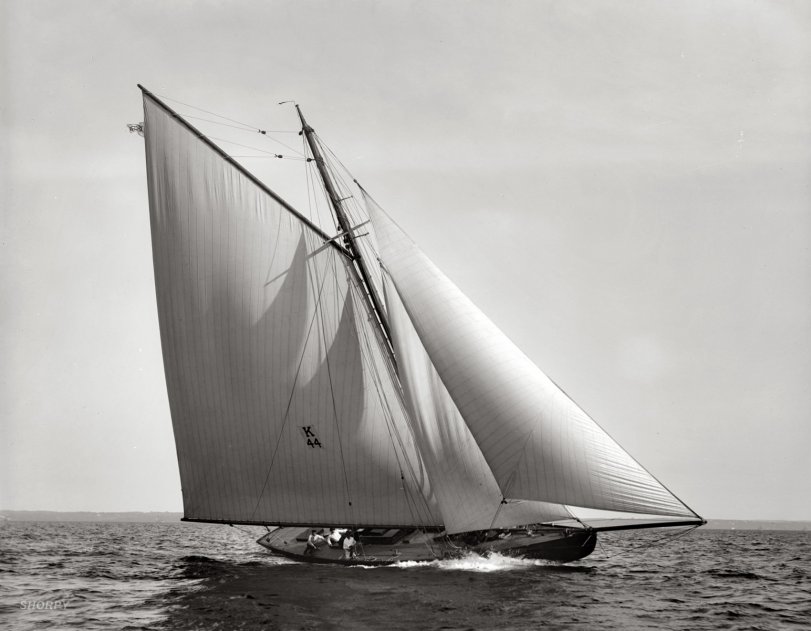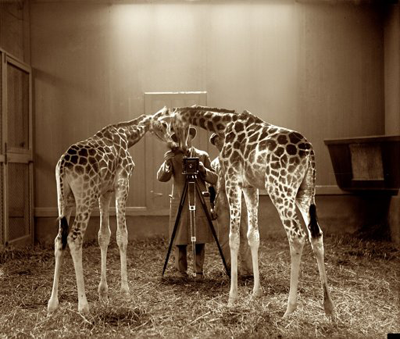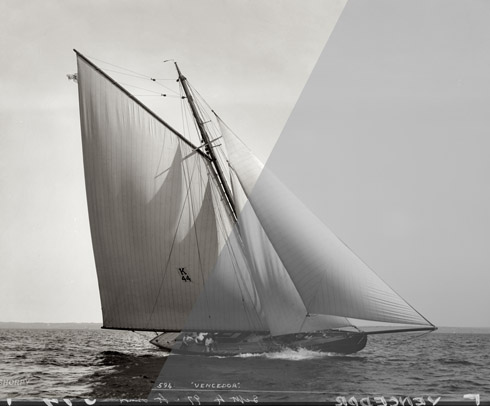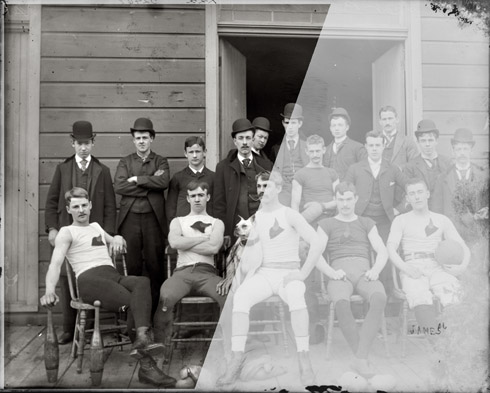


Framed or unframed, desk size to sofa size, printed by us in Arizona and Alabama since 2007. Explore now.
Shorpy is funded by you. Patreon contributors get an ad-free experience.
Learn more.

- What a headache!
- Baldwin 62303
- Baldwin VO-1000
- Cold
- No expense spared
- Tough Guys
- Lost in Toyland
- And without gloves
- If I were a blindfolded time traveler
- Smoke Consumer Also Cooks
- Oh that stove!
- Possibly still there?
- What?!?
- $100 Reward
- Freeze Frame
- Texas Flyer wanted
- Just a Year Too Soon
- WWII -- Replacing men with women at the railroad crossing.
- Yes, Icing
- You kids drive me nuts!
- NOT An Easy Job
- I wonder
- Just add window boxes
- Icing Platform?
- Indiana Harbor Belt abides
- Freezing haze
- Corrections (for those who care)
- C&NW at Nelson
- Fallen Flags
- A dangerous job made worse
Print Emporium
Vencedor: 1897

September 4, 1897. Commodore H.M. Gillig's racing sloop Vencedor on Lake Erie. Photo by John S. Johnston. Detroit Photographic glass negative. View full size.
I know
That this was posted over a year ago, but I just found it! Magnificent picture! Perfect "wallpaper" shot!! You do come up with some really special "moments in time"!
[Don't we!!!!! - Dave]
Making waves
This is the rare instance when you'll have to concede the point, Dave. It took a few minutes to load, but the gigantic 7240 x 5776 pixel .tiff of the Vencedor displays just fine in my Safari browser, both in full-size and in "fit to screen" mode.
[Try this one then. I stand by my point. You use an image editor, not a Web browser, to open a big tiff. You can empty a bathtub with a teaspoon, but for obvious reasons nobody does it. - Dave]
The Giraffes
Ahem. Actually, I DO see them (and the photographer, or I guess he's the *other* photographer). Beautiful shot.
It's not like I didn't try dragging a .tiff onto my browser to check before posting the comment, you know.
Maybe this is a Mac thing. I'm on Safari, totally stock install, and I can look at .tiffs in it all day long with no trouble. Had no idea IE and FF were handicapped in this regard.
[If you are one of the lucky 3.4 percent of surfers out there using Safari on a Mac or Windows machine, you can indeed view tiffs with your Web browser. Only smallish ones though. As for the full-res tiffs that we extract our jpegs from, you would probably have trouble viewing them in Safari. - Dave]
Tiffs
Just for accuracy's sake, I will point out that .tiffs do not in fact require 'specialized software' to view; your average browser will open them just fine. The rest of your point, about the fact that you have done substantial restoration work on the images, is quite reasonable.
[You're mistaken. Neither Internet Explorer nor Firefox will display a tiff without a third-party plug-in or add-on. If you don't see the picture of two giraffes immediately below, there's your proof. - Dave]

Amazing yacht but one thing....
Love the blog but one thing - why do you watermark the images with 'Shorpy' when I thought they are Library of Congress released under Creative Commons?
Or are the watermarked ones not LOC? Couldn't there be a prior claim on them? Just seems a bit odd, that's all.
[The Shorpy logo is there for two reasons. To publicize the site, since the images here appear on dozens of other websites almost as soon as they're posted; and to show authorship -- who created this jpeg, which is not simply a downsized version of the LOC tiff. (jpegs, which are what you see here, are image files that can be viewed with a Web browser; tiffs are much larger files that require specialized software to view.) The starting point for the sailboat was a 40-megabyte reference tiff (download) on the Library of Congress servers. It was opened in an editing program (Photoshop CS3) and adjusted for color, contrast and various other parameters to come up with the image you see here. Click on the sailboat below for an example; it took about an hour to extract this jpeg from the reference tiff. On the right is the image as it appears on the LOC servers; on the left is the image as it appears on Shorpy. Below that is a second example. - Dave]
Another recent example below. Click here to enlarge. Compare the full-size Shorpy image to the closest match on the LOC site.
Film
"This wasn't shot on film. Generally speaking, "film" didn't exist in 1897."
I hate to disagree with you Dave (oh who am I kidding - I like it), but it's probably better to say that film was not the medium of professional photographers in 1897. After all, George Eastman had developed his first roll film emulsion in 1884 and patented his first Kodak roll film camera in 1888. I recall reading that by 1896 the company had sold 100,000 of the film cameras.
[Most of the roll film of that era, like the rolls used in that first Kodak camera, was sensitized paper, not film the the modern sense, i.e. a clear substrate coated with emulsion. - Dave]
Shutter Speed?
Fast film for 1897. Could not have been handheld, methinks.
[This wasn't shot on film. Generally speaking, "film" didn't exist in 1897. - Dave]
Hang on Sloopy
For the kind of weight a boat of that era must have had, that is a lot of sail area for that size boat. I bet it would move and you can see the crew is braced in!
Gaff Rig, they could even fly some more sail up in that little triangular area aft the top of the mast.
I was looking for the "Bekin of Cowes" Marque
Wonderful picture.


























On Shorpy:
Today’s Top 5